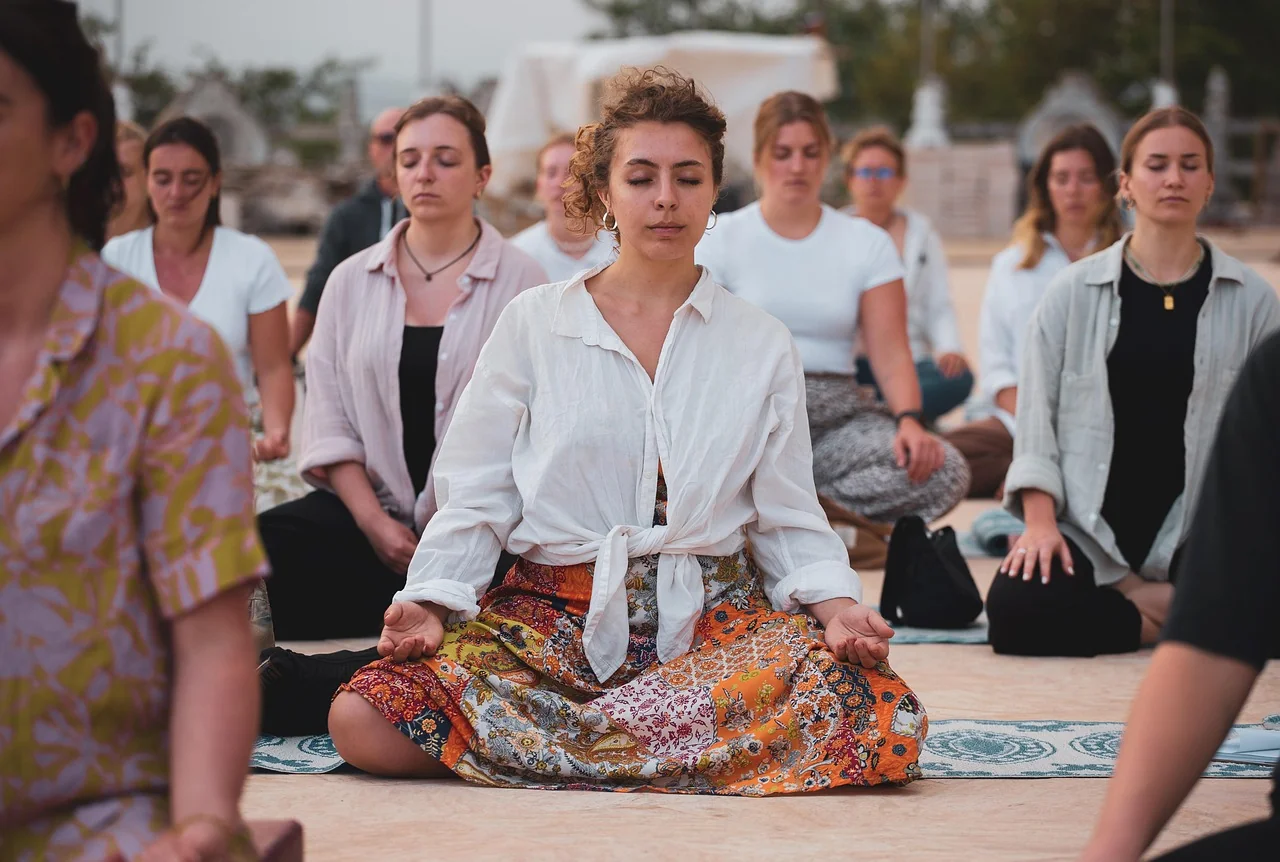Feeling the pressure of the American hustle? You're not alone. Between the constant ping of notifications, the blur of a busy workweek, and the general noise of modern life, finding a moment of quiet can feel like a radical act. This is where the powerful practice of USA meditation comes in—not as an esoteric escape, but as a practical, evidence-backed tool to reclaim your focus and find your center right here, right now. It’s a growing movement helping millions from coast to coast combat stress, enhance creativity, and simply breathe deeper amidst the chaos. This guide is your modern roadmap. We’ll cut through the confusion and show you exactly how to start a simple practice, explore the top apps and local resources, and seamlessly weave mindfulness into your uniquely American lifestyle. Get ready to discover that the peace you’re searching for is already within you; you just need to learn how to access it.
Why Meditation is Booming Across the USA
The image of meditation in America has transformed. It's no longer seen as a niche activity for monks on mountaintops but as a mainstream tool for mental fitness. This cultural shift is driven by a powerful combination of science and societal need. The modern American lifestyle, with its relentless pace and constant connectivity, has created an epidemic of stress and burnout. People are actively seeking solutions that work, and the benefits of meditation are now too significant to ignore.
Neuroscience has put meditation on the map. Brain imaging studies show that a consistent practice can physically change the brain, strengthening areas responsible for focus, emotional regulation, and empathy while calming the amygdala, our fear center. For a society increasingly focused on wellness and performance, this biological evidence is compelling. It’s not just spiritual; it’s scientific.
Furthermore, the conversation around mental health in America has opened up dramatically. As we collectively work to destigmatize issues like anxiety and depression, mindfulness in America has emerged as a proactive, accessible strategy for mental hygiene. Just as we go to the gym for physical health, millions now see meditation as a daily workout for the mind. This perfect storm of cultural need, scientific validation, and a growing wellness economy has propelled meditation from the fringe to the forefront of American life.
A Beginner's Guide to USA Meditation Techniques
Starting a meditation practice can feel daunting, but it’s far simpler than most people think. You don’t need special equipment or hours of free time. You just need a few minutes and a willingness to try. Here are three foundational techniques popularized across the United States that are perfect for beginners.
Mindfulness Meditation
This is arguably the most popular form of USA meditation, often forming the core of programs like Mindfulness-Based Stress Reduction (MBSR). The goal is simple: to pay attention to the present moment without judgment.
- How to do it: Find a quiet seat, close your eyes, and bring your attention to your breath. Notice the sensation of the air moving in and out of your body. Your mind will wander—to your to-do list, a memory, a worry. This is completely normal. The entire practice is the act of noticing that your mind has wandered and gently bringing it back to the breath, without criticizing yourself. For a dedicated guide on this process, see our beginner's guide on meditation to clear your mind.
- Why it works for Americans: It cultivates the ability to pause and respond thoughtfully rather than react impulsively, a superpower in our fast-paced environment.
Guided Meditation
If sitting in silence feels intimidating, guided meditation is your perfect entry point. In this practice, a teacher or a recorded audio voice leads you through a meditation, providing instructions and often a narrative to focus on.
- How to do it: All you need is a smartphone and a pair of headphones. You can use a meditation app, a YouTube channel, or a podcast. The guide might lead you through a body scan, a visualization, or a simple breathing exercise. Your job is just to listen and follow along.
- Why it works for Americans: It’s incredibly accessible and requires zero prior knowledge. It’s like having a personal trainer for your mind, making it easy to fit into a busy schedule.
Mantra Meditation
This technique involves the silent repetition of a word, sound, or phrase to anchor your attention. It’s a powerful way to quiet the internal chatter of the mind.
- How to do it: Choose a mantra. This could be a traditional Sanskrit word like "Om," a positive affirmation like "I am calm," or even a neutral word like "peace." Sit quietly with your eyes closed and begin to repeat the mantra silently in your mind. When your attention drifts, gently return to the repetition of the sound.
- Why it works for Americans: It gives the busy mind a single, simple task to focus on, which can be more accessible than focusing on the breath for some people.
Top Resources for Your USA Meditation Practice
One of the greatest advantages of practicing USA meditation today is the wealth of resources at your fingertips. Whether you prefer a structured app, an on-the-go podcast, or a local class, there’s a tool to support your journey.
The Best Meditation Apps
Meditation apps have democratized the practice, putting thousands of guided sessions in your pocket. The top contenders are:
- Calm: Known for its beautiful visuals and soothing soundscapes, Calm offers a wide variety of content, including daily guided meditations, Sleep Stories narrated by celebrities, and masterclasses from mindfulness experts.
- Headspace: With its friendly, approachable animation and style, Headspace is fantastic for beginners. It offers themed packs (for anxiety, focus, sleep) and short, "mini" meditations for busy days.
- Ten Percent Happier: Founded by ABC news anchor Dan Harris after a panic attack on live television, this app is for the skeptic. It features practical teachings and interviews with world-class teachers, focusing on the real-world application of meditation.
- Healthy Minds Program: This is a fantastic, completely free app from a non-profit institute. It’s structured as a curriculum, grounded in neuroscience, and offers a comprehensive journey through the fundamentals of meditation.
Must-Listen Meditation Podcasts
For those who learn well through listening, the best meditation podcasts offer a no-cost way to explore different teachers and techniques.
- The Daily Meditation Podcast: Offers a new 10-minute guided meditation every day, perfect for establishing a consistent morning or evening routine.
- Tara Brach: A renowned psychologist and meditation teacher, Tara’s podcast blends profound Dharma talks with guided meditations, focusing on radical acceptance and compassion.
- Meditation Minis: If you're short on time, these sub-10-minute guided sessions are designed to quickly reduce anxiety and build confidence.
Finding Local Meditation Classes
While digital resources are convenient, connecting with a local community can be deeply rewarding. To find local meditation classes, start by searching for "meditation centers near me" or "mindfulness classes" in your city. You can also check:
- Yoga Studios: Most yoga studios now offer dedicated meditation classes or workshops.
- Community Centers: Many local parks and rec departments have added wellness and meditation to their class schedules.
- Universities and Hospitals: These institutions often host MBSR (Mindfulness-Based Stress Reduction) courses, which are gold-standard, eight-week programs.
Weaving Meditation into the American Lifestyle
The biggest hurdle for many Americans isn't learning how to meditate, but finding the time. The key is to let go of the idea that you need a perfect, 30-minute silent session. A daily meditation practice is built on consistency, not duration. Here’s how to make it work with your real life.
Start Small and Anchor Your Habit Commit to just five minutes a day. Trying to do too much too soon is a recipe for quitting. Link your practice to an existing habit to make it stick. Meditate right after you brush your teeth in the morning, during your first coffee, or right before you check your email for the day. This "habit stacking" makes it automatic.
Leverage "Wasted" Time Your daily routine is filled with micro-opportunities for meditation for stress. You don't always have to be on a cushion.
- Commute Meditation: On the train or bus? Instead of scrolling, close your eyes and focus on your breath for just five stops. If you're driving, try a few minutes of mindful driving, noticing the feeling of your hands on the wheel.
- The Mindful Minute: Before a big meeting, a difficult conversation, or when you feel overwhelmed, take 60 seconds. Close your eyes, take three deep breaths, and check in with your body. This acts as a "reset" button for your nervous system.
- Mindful Chores: Turn dishwashing or folding laundry into a meditation. Pay full attention to the sensations: the warmth of the water, the texture of the fabric. When your mind wanders to your worries, gently bring it back to the task.
Involve the Family Meditation for families is a growing trend. A short, two-minute "breathing break" before homework or a simple guided meditation before bed can help children (and parents) manage big emotions and improve sleep.
Finding Community: Meditation Centers and Retreats in the USA
While a personal practice is powerful, deepening your journey often involves connecting with others. The United States is home to a vast network of in-person communities and immersive retreats that can profoundly accelerate your understanding.
Exploring Local Meditation Centers
Joining a meditation center provides structure, support, and direct access to experienced teachers. When searching for "meditation centers near me," you'll find a diverse range:
- Buddhist Centers: Many cities have Zen centers, Tibetan Buddhist centers, or Vipassana groups that offer regular sitting sessions, teachings, and introductory courses. They are often welcoming to people of all faiths and backgrounds.
- Secular Mindfulness Centers: These centers focus purely on the practical benefits of meditation without any religious or spiritual framework. They are ideal for those who want the training without the doctrine.
- Yoga Studios & Wellness Lounges: As mentioned, these are increasingly common hubs for community meditation.
Visiting a center allows you to ask questions, learn proper posture, and feel the collective energy of a group sitting in silence—an experience that is uniquely powerful.
The Transformative Power of a Retreat
For those ready to dive deeper, a meditation retreat USA offers an unparalleled opportunity. A retreat removes you from the distractions of daily life, allowing you to immerse fully in your practice for a weekend, a week, or longer.
- Types of Retreats: Options range from silent Vipassana retreats, where you refrain from speaking and eye contact to turn inward, to guided retreats with a mix of meditation, teaching, and community interaction.
- Finding a Retreat: Renowned centers like the Omega Institute (NY), Spirit Rock (CA), and the Insight Meditation Society (MA) offer world-class retreats. A simple search for "meditation retreat USA" will reveal options in nearly every state, from rustic cabins to comfortable wellness resorts.
- What to Expect: A retreat can be challenging but profoundly rewarding. It’s a chance to reset your nervous system, gain new insights, and return to your life with a renewed sense of clarity and calm.
Conclusion: Your Journey with USA Meditation Starts Now
The path to a calmer, more focused, and resilient life doesn't require a passport or a drastic lifestyle change. The tools for USA meditation are all around you, waiting to be used. This practice is a gift you give to yourself—a small pocket of peace in a demanding world. It’s not about achieving a perfectly empty mind, but about learning to be present with the mind you have, with kindness and curiosity. To see the kind of transformation that's possible, read about one person's meditation experience after three months of practice.
You now have the map: simple techniques to try, a list of the best apps and podcasts, strategies for fitting it into your day, and pathways to find community. The only step left is the first one. Find a quiet spot, set a timer for just three minutes, and focus on your next breath. Then the one after that. Your journey to finding your center in the heart of the American hustle begins with a single, conscious breath.
In conclusion, the practice of meditation offers a powerful and accessible antidote to the high-speed demands of modern American life. As explored, the benefits are profound and multifaceted, encompassing reduced stress, enhanced emotional resilience, and sharper mental clarity. The journey into mindfulness is remarkably democratic, requiring no special equipment or beliefs, only a willingness to begin. Whether through guided apps, a local class, or a few minutes of daily silence, the path is open to all. The most significant step is always the first one. By committing to just a few minutes each day, as explored in our piece on twenty minutes meditation, you can move from being overwhelmed by your circumstances to cultivating a grounded, responsive presence. This simple, ancient practice holds the key to not only navigating but truly thriving amidst the chaos, empowering you to build a more peaceful and focused life from the inside out. Your journey toward a calmer mind and a more centered existence begins now.


